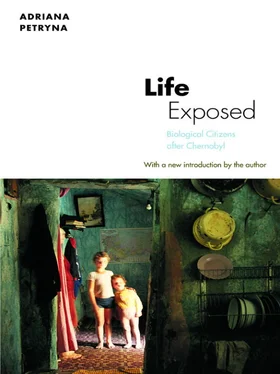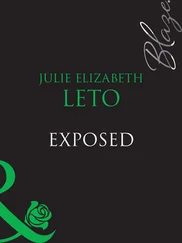Within radiobiological laboratories, the impact of radiation induction on experimental animals or human cells is described in terms of a biological event. Indicators of biological events, or “biomonitors” (for example, dosage, type of damage, repair, fixation, cell cycle status, differentiation status, microenvironment, hormonal status, and the age of the organism), help identify stages of a carcinogenetic process in experimental animals and inform an etiology of occupationally induced cancers in humans. These indicators are part of the technical means for monitoring exposed populations. However, values internal to the strategies and goals of scientific institutions often drive the selection of the biological sites considered (for example, a cleft palate versus a genetic mutation on chromosome 2). The particular “site” chosen influences the interpretation of the medical consequences of a radiation exposure event; this interpretation, in turn, may serve as a measure for what counts as normal life and a normal life expectancy in populations identified as being at risk.
In the paragraphs that follow, I describe how the issue of biomonitoring for populations was introduced and exchanged between Western (mainly American) and Soviet-bloc scientists in the context of the International Chernobyl Project (1991). [30] See IAEA 1991a, 1991b.
In October 1989, three years after the accident, the Soviet government requested assistance from the International Atomic Energy Agency (IAEA) to coordinate an international expert assessment of the Soviet Safe Living Concept, which the government had introduced in the previous year, for inhabitants of contaminated areas. A meeting held in Vienna in May 1991 brought the authority of the world’s leading scientists and specialists to bear on the expressed-task of instilling confidence in the affected populations, with the objective of stamping out the “obscurantism” and “sensationalism” that arose concerning the accident’s medical effects. The project had the exclusive aims of radiation protection and the restoration of public trust among unresettled populations; it “sought to provide a sound scientific basis for a decision yet to be made.” It noted that a “poor understanding in affected areas of the scientific principles underlying radiation and its effects… was the root of many medical and social problems observed” (IAEA 1991a:6). An official report, published later that year, accentuated state-of-the-art measures that were being taken into account in the assessment of the accident’s long-term health effects.
On the one hand, the Soviet scientists claimed to have lacked an acceptable system of biodosimetry (a system of internal biological dose calculation and estimation). [31] Professor Kindzelskyi of the Radiation Oncology Institute in Kyiv explained how the 35-rem limit, for example, was deduced: based on North American studies, “0.5 rem is what a nuclear plant worker receives. This is the maximum safe dose. And then they multiplied 0.5 by seventy years (a possible life span) to get 35 rem.” For further explication of the negotiation of the threshold, see Chernousenko 1991.
The United States, on the other hand, had sponsored sustained research in biodosimetry and radiation health effects since the bombings of Hiroshima and Nagasaki, and in the wake of nuclear weapons testing, human experimentation, and various medical radiological procedures. One immediate effect of this scientific collaboration was the transference of Western biodosimetric technologies to the Soviets as part of consensus-building efforts. Another effect of this collaboration was the international confirmation (under severe public criticism) of Soviet selective remediation strategies and the Safe Living Concept.
Some issues remained unsolved, however. How were the scientists to convert the scale of the Chernobyl accident into plausible biodosimetric data five years after the event? Recall that in the radiobiological experimental context, data are unique to the indicators and the biological events that are selected. Similarly, biodosimetric systems are interpretive measures associated with specific radiation exposure events (the first biodosimetric system related to Hiroshima was the result of roughly twenty years of research on human subjects). Not surprisingly, the Vienna meeting was marked by negotiations over the value of individual radiobiological claims. The specifics of where, when, and how researchers should medically interpret radiation induction in biological samples taken from affected individuals became a source of contention and scientific collaboration. This was especially true with respect to the question of how human inhalation of hot particles (radioactive dust and debris from the reactor core) could best be addressed. The following samples of the discussions among the scientists provide a sense of this give-and-take.
E. P. Petryaev of the Department of Radiation Chemistry, State University of Belarus, presented photographs of necrosed lung tissue of Chernobyl accident cleanup workers who were not included in the official patient cohort, and who had died.
The content of these [hot] particles on the surface varies but attains very high levels, particularly for samples from the Zone where we observed up to 10 particles per cm 2…. So far we have studied the autopsy material from the lungs from about 300 people whose deaths were due to various causes. Samples of lung were also obtained after operations. A definite relationship between the content of particles and the concentration of radioactive substances on the surface was found. …, hot particles were found in the lungs in about 70% of the 300 samples. (IAEA 1991b:27)
Petryaev’s claims were essentially dismissed as irrelevant to radiation protection. L. R. Anspaugh of the IAEA and Lawrence Livermore National Laboratory of the United States responded:
After several trips to the USSR, I am absolutely convinced that ‘hot particles’ do exist. I have certainly seen many radiographs in several of the laboratories I visited.
The really important question is: What do they mean in terms of dose and health effects?…, the next important questions are: How many of them are there and how much activity is in the lung? (Ibid.)
IAEA experts’ dismissive approach should not be surprising as one of their concerns is to advance nuclear energy. But there are ethical issues for which experts need to be held accountable in their readiness to ignore the significance of raw tissue data and then to blame the local scientists for an alleged inadequate knowledge of radiation protection. In this vein, Anspaugh shifted discussion away from the samples to more abstract questions of “counting the hot particles.” A. J. Gonzalez of the Division of Nuclear Safety of the IAEA, Vienna, seconded Anspaugh’s move:
At the risk of repetition, I should say that there is a very clear recommendation… which basically indicates that a given activity incorporated into a tissue as hot particles carries less risk of cancer induction than the same activity uniformly distributed in such tissue…. If the activity is uniformly distributed, the number of target cells will be higher, and therefore the risk will also be higher. The photographs showing tissues with necrosis due to hot particles presented here are very impressive but have little relevance to radiation protection . (Ibid.:28; emphasis added)
There was a striking variety in the kinds of evidence submitted by Soviet and Western scientists to support their differing interpretations of the Chernobyl event’s health effects. For local scientists, photographs of necrosed lung tissue mattered most. For IAEA experts, it was the number of “potentially activated target cells.” Implicit was a consensual valorization of public health, understood in specific terms: a normative notion of risk was quantified in the correct biological contexts (target cells, as opposed to necrosed lungs), with the correct biological value, and in the correct representational form.
Читать дальше












